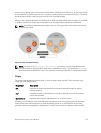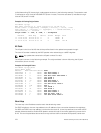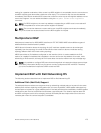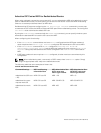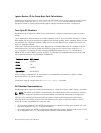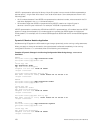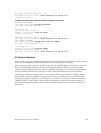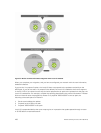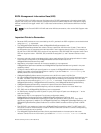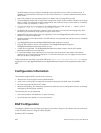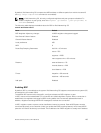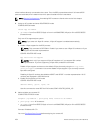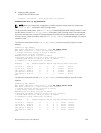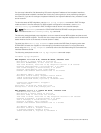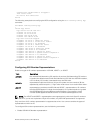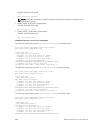
BGP4 Management Information Base (MIB)
The FORCE10-BGP4-V2-MIB enhances Dell Networking OS BGP management information base (MIB)
support with many new simple network management protocol (SNMP) objects and notifications (traps)
defined in
draft-ietf-idr-bgp4-mibv2-05. To see these enhancements, download the MIB from the Dell
website.
NOTE: For the Force10-BGP4-V2-MIB and other MIB documentation, refer to the Dell iSupport web
page.
Important Points to Remember
• Because eBGP packets are not controlled by the ACL, packets from BGP neighbors cannot be blocked
using the deny ip command.
• The f10BgpM2AsPathTableEntry table, f10BgpM2AsPathSegmentIndex, and
f10BgpM2AsPathElementIndex are used to retrieve a particular ASN from the AS path. These indices
are assigned to the AS segments and individual ASN in each segment starting from 0. For example, an
AS path list of {200 300 400} 500 consists of two segments: {200 300 400} with segment index 0 and
500 with segment index 1. ASN 200, 300, and 400 are assigned 0, 1, and 2 element indices in that
order.
• Unknown optional transitive attributes within a given path attribute (PA) are assigned indices in order.
These indices correspond to the f10BgpM2PathAttrUnknownIndex field in the
f10BgpM2PathAttrUnknownEntry table.
• Negotiation of multiple instances of the same capability is not supported.
F10BgpM2PeerCapAnnouncedIndex and f10BgpM2PeerCapReceivedIndex are ignored in the peer
capability lookup.
• Configure inbound BGP soft-reconfiguration on a peer for f10BgpM2PrefixInPrefixesRejected to
display the number of prefixes filtered due to a policy. If you do enable BGP soft-reconfig, the
denied prefixes are not accounted for.
• F10BgpM2AdjRibsOutRoute stores the pointer to the NLRI in the peer's Adj-Rib-Out.
• PA Index (f10BgpM2PathAttrIndex field in various tables) is used to retrieve specific attributes from the
PA table. The Next-Hop, RR Cluster-list, and Originator ID attributes are not stored in the PA Table
and cannot be retrieved using the index passed in command. These fields are not populated in
f10BgpM2PathAttrEntry, f10BgpM2PathAttrClusterEntry, and f10BgpM2PathAttrOriginatorIdEntry.
• F10BgpM2PathAttrUnknownEntry contains the optional-transitive attribute details.
• Query for f10BgpM2LinkLocalNextHopEntry returns the default value for Link-local Next-hop.
• RFC 2545 and the f10BgpM2Rfc2545Group are not supported.
• An SNMP query displays up to 89 AS paths. A query for a larger AS path count displays as "…" at the
end of the output.
• SNMP set for BGP is not supported. For all peer configuration tables
(f10BgpM2PeerConfigurationGroup, f10BgpM2PeerRouteReflectorCfgGroup, and
f10BgpM2PeerAsConfederationCfgGroup), an SNMP set operation returns an error. Only SNMP
queries are supported. In addition, the f10BgpM2CfgPeerError, f10BgpM2CfgPeerBgpPeerEntry, and
f10BgpM2CfgPeerRowEntryStatus fields are to hold the SNMP set status and are ignored in SNMP
query.
• The AFI/SAFI is not used as an index to the f10BgpM2PeerCountersEntry table. The BGP peer’s AFI/
SAFI (IPv4 Unicast or IPv6 Multicast) is used for various outbound counters. Counters corresponding
to IPv4 Multicast cannot be queried.
• The f10BgpM2[Cfg]PeerReflectorClient field is populated based on the assumption that route-
reflector clients are not in a full mesh if you enable BGP client-2-client reflection and that
Border Gateway Protocol IPv4 (BGPv4)
181



